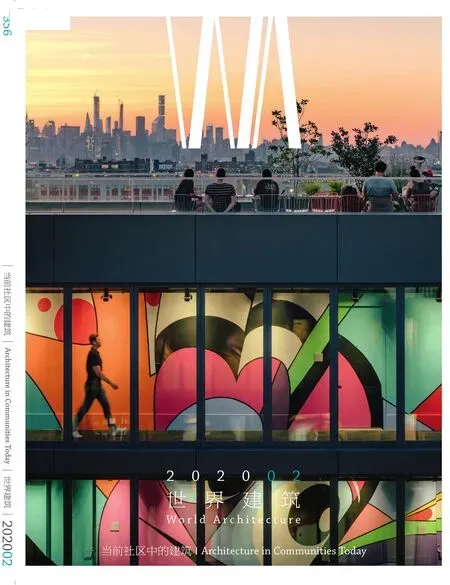社区建设
——建筑学的伦理功能:点、线、面、网
维罗妮卡·吴/Veronica Ng
徐知兰 译/Translated by XU Zhilan
今天怎样形成有感染力的空间,来帮助社区建设?而建筑学在其中发挥什么作用?建筑学不可避免的一项伦理功能就是为社区营造建筑。在马来西亚,为社区设计的建筑通常被称为社区中心和社区大厅(或马来语的“大会堂”),大多建成于1980年代和1990年代。就目前来看,人们大多认为这些社区建筑无法满足当代人对社区的要求[1],且利用效率很低[2]。现在,建筑师们还为社区做设计吗?或者说,建筑师们还出于社区建设的目的做建筑设计吗?
以此为出发点,本文探索了建筑学在当代马来西亚城市环境下进行社区建设的过程中起到的作用。文章提出,现当代背景下社区概念的发展已经改变了建筑学在社区建设中的功能地位。本文借鉴西方中心主义人文学科对社区的社会学定义,对社区概念的变迁及其相关的若干社会空间关系概念进探讨,然后通过马来西亚的若干案例来说明这些因素如何帮助实现社区的形成。这些案例的规模不尽相同,被象征性地分为点、线、面和网。
1 “社区”的定义及其概念的变化
社区的概念来自社会学,并在今天被人们广泛使用。按照定义,社区是指共享某些事物的人群。它作为一种社会结构,由其中具有共同属性的人们构成,并且也/或由人们之间的关系强度来定义。在社会学语境下,社区指像郊区、都市等这一类的人口聚居区类型;指为这些聚落所设想的典型理想生活方式;除了拥有共同的居住地外,也指代由拥有其他共同属性的成员所构成的社会网络结构。
人们在社区中体验到的共同属性就是“社区意识”:“其成员在其中感受到隶属于彼此,并意识到彼此之间非常重要的关系,并且都相信他们的需要能通过彼此共同遵守的承诺得到满足的观念”[3]。麦克米伦和查维斯在其1986年的重要研究中定义了“社区意识”的4项要素:
(1)会员关系:归属感或共同拥有个人社会关系的感觉;
(2)影响力:举足轻重的感觉,能对一群人产生影响,或一个群体能对其成员产生影响;
(3)支持:整合与满足需求;
(4)共同的情感联系。
为了理解建筑学在社区建设中的作用,有必要把社区理解为类似的跨学科概念,如地域意识、场所营造、第三空间和共享空间等。其中,与建成环境相关的人际关系和依恋关系被定义为称作“地域意识”的社会学现象。在具有强烈“地域意识”的场所,居民和游客都能体会到强烈的归属感。在建筑学中,地域意识既和背景环境有关,也和建筑或场所的身份认同或其独一无二的特点有关,它们对使用者来说很有意义。正如地域意识与一处场所“是什么”有关,场所营造则与“如何”营建一处场所,并由此形成社区有关。
场所营造是对公共空间进行跨学科的全方位规划、设计与管理的过程。这个概念与地理学、城市规划、城市设计、景观建筑学、环境心理学、社会学等学科都有交叉。公共空间项目(PPS)提出场所营造是“我们为了最大程度获得共享价值而营造公共领域的整体过程”。场所营造不仅推广了更优秀的城市设计,也形成了创新的使用功能,它尤其关心形成和支持一处场所不断发展的物质空间、文化认同和社会身份认同因素。
根据公共空间项目的研究,能在建成环境中对社区公共空间产生影响的几项因素包括可通达与交通便利程度,舒适与美观程度,使用功能、社会活动与可进行社会交往的程度等。此外,影响人们对一些空间环境格外偏好的形式要素是空间的连贯程度、可理解程度、复杂度和神秘感[4]82-87。为了让人们能立刻理解环境的空间关系,环境的连贯性(以明确意义)和复杂的程度(以鼓励参与)都能帮助人们理解空间。而更长期地看,可理解程度和神秘感更进一步鼓励人们探索空间。
考虑到公共领域和社区之间有许多关联,“第三空间”作为社会学的概念,提供了如何理解空间特点在社区建设中的作用。目前在马来西亚和许多其他亚洲地区出现的社区建设的现象都可以从“第三空间”的角度进行阐释。
2 作为社区客厅的第三空间
“第三空间”是一个描述公共生活的概念,它源于我们对休闲放松、社会交往、闲暇娱乐和单纯地享受美好时光的向往。根据雷·奥尔登堡的观点,这样的环境能被称为“第三空间”,和家庭环境的第一空间和作为工作或学习场所的第二空间相对应[5]。
雷·奥尔登堡作为一名城市社会学家,在其1991年首版的著作《绝好的地方》一书中提出了“第三空间”概念,用来指代社区建筑的概念。奥尔登堡描述了非正式的公共聚会场所对社区和公共生活来说如何具有举足轻重的作用——而这些第三空间正是社区社会活力的核心所在。这些场所包括酒吧、咖啡馆、各类商店等等。此外,奥尔登堡在其著作《第三空间礼赞》(2001)中把第三空间定义为人们能够在其中聚会或交往的中性公共空间[6]。相对于第一空间(居家环境)和第二空间(办公场所)来说,第三空间“为人们在家庭和工作的领域之外,提供了能够经常、主动、愉快而非正式地聚集在一起的机会”。
第三空间具有许多社区建筑的重要特征。许多致力于恢复和/或营造邻里关系的城市规划工作,现在都包含了第三空间的建设内容,尤其是试图打破社交孤岛的公共空间。
公共生活所需的建成环境并不必须是公共空间。公共生活的个人领域由消费者文化和新的“体验经济”所提供的机会共同构成[7]。2009年,杰夫里斯等人在他们的研究中把下列这些空间类型也拓展为潜在的第三空间:社区中心、老年活动中心、咖啡馆和小吃店、酒吧和夜店、餐厅、购物中心、各类商店、购物广场、露天市场、美发沙龙、美容会所、休闲中心、基督教(女)青年会、游泳池、电影院、教堂、学校、高等院校、俱乐部和社团组织、图书馆、公园和其他户外活动场所、街道、社区花园、住宅和公寓,还有类似社区聚会、街区聚会、野炊聚会、烧烤聚会、小镇公民大会、宾果游戏和各类媒体(网络媒体、时事通讯、报纸、电话、公告栏)等[8]。
What makes conducive places that build communities in today's context? And, what is the position of architecture within this? Inevitably,one of the ethical roles of architecture is to create buildings for community. In Malaysia, buildings designed for community, commonly called community centre and the community hall [or the dewan in Malaysian language] are from earlier decades, built mostly during the 1980s and 1990s. As it stands today, the common critique on community building is its lack of fulfillment of the community's contemporary requirements[1], and these spaces are underutilised[2]. Today, do architects design for communities? Or do architects design to build communities?
Taking this as the point of departure, this article explores the position of architecture in the creation of communities within the contemporary Malaysian urban settings. It argues that the evolving notions of community within the contemporary contexts have altered the role of architecture in the function of building communities. Borrowing from the sociological definition of community from Western-centric literature, this article discusses the changing notions of community and several related socio-spatial concepts, and subsequently illustrates how these enable the creation of communities by providing some exemplars within the Malaysian context.
1 The definitions and changing notions of"community"
The notion of community is rooted in the discipline of social science, and is loosely used today.By definition, a community is a group of people who share something in common. It is a social construct defined by the shared attributes of the people in it and/or by the strength of the connections among them. In sociological literature, community refers to types of population settlements such as rural community, urban community, to supposedly ideal-typical ways of life in such places and to social networks whose members share common characteristics apart from or in addition to common location.
The commonality within a community is experienced as a "sense of community" - "a feeling that members have of belonging and being important to each other, and a shared faith that member's need will be met by their commitment to be together"[3]. In a seminal 1986 study, McMillan and Chavis identified four elements of "sense of community":
(1) membership: feeling of belonging or of sharing a sense of personal relatedness,
(2) influence: mattering, making a difference to a group and of the group mattering to its members,
(3) reinforcement: integration and fulfillment of needs, and
(4) shared emotional connection.
In understanding the role of architecture in building communities, it is necessary to understand community as a trans-disciplinary notion synonymous to concepts such as sense of place, place-making,third place, and shared space. The connection and attachment related to the built environment is defined as a social phenomenon called "sense of place". Places said to have a strong "sense of place" have a strong identity that is deeply felt by inhabitants and visitors.In architecture, sense of place is about context as well as the identity or unique characteristics of a building or space that create meaning for an occupant. While sense of place is related to "what" is it about a place, placemaking is related to the "how" places can be created,hence forming community.
Place-making is a multi-disciplinary and multifaceted approach to the planning, design and management of public spaces. This notion intersects fields of geography, urban planning, urban design landscape architecture, environmental psychology,sociology. The Project for Public Space (PPS) defines place-making as a "collaborative process by which we shape our public realm in order to maximise shared value. More than just promoting better urban design, place-making facilitates creative patterns of use, paying particular attention to the physical,cultural, and social identities that define a place and support its ongoing evolution".
According to the Project for Public Space,several factors of the built environment that impact on public spaces for community are access and linkage, comfort and image, uses and activities,and sociability. Also, informational qualities that contribute to people's preferences for particular physical environments are coherence, legibility,complexity and mystery[4]82-87. For an immediate appreciation of environments, understanding is supported by environmental coherence (to make sense) and complexity (to encourage involvement).In the longer term, legibility and mystery encourage further exploration.
While there are many connections between the public realm and community, the notion of third place, a sociological concept, offers a means to unpack how spatial characteristics play a role in building communities. A current phenomenon of building communities seen in Malaysia and many of the Asian counterparts can be explained from the perspective of "third place".
2 The notion of third place as the community's living room
One of the concepts of public life that is derived from our desire for relaxation, social contact, entertainment, leisure, and simply having a good time is termed "third place". According to Ray Oldenburg[5], such settings can be called "third places", as opposed to the first place of home or the second place of work or school.
The concept of "third place" proposed by Ray Oldenburg, an urban sociologist, in his book titled The Great Good Place, first published in 1991, is a term used in the concept of community building.Oldenburg demonstrated how the importance of informal public gathering places are esssential to community and public life - third places are the heart of a community's social vitality. Examples of these places include bars, coffee shops,general stores. Further to this, Oldenburg's book Celebrating the Third Place (2001) identified third places as public spaces on neutral ground where people can gather and interact[6]. In contrast to first places (home) and second place (work), third places"host the regular, voluntary, informal and happily anticipated gaterhings of individuals beyond the realms of home and work".
Third places have a number of important community-building attributes. Many urban planning efforts to reinvigorate and/or create neighbourhoods now include creation of third places, especially public spaces to try and break down social silos.
The settings for such public life are not necessarily public spaces. Individual orbits of this public life are shaped by a consumer culture and the opportunities offered by the new "experience economy"[7]. Jeffres et al. expanded the following types of environments as possible third places,considered in their research: community centres,senior centres, coffee shops and cafes, bars and pubs, restaurants, shopping centres, stores, malls,markets, hair salons, barber and beauty shops,recreation centres, YM/WCA, pools, movie theatres,churches, schools, colleges and universities, clubs and organisations, libraries, parks and other places allowing for outdoor recreation, streets, neighbours'yards, homes and apartments, and events like neighbourhood parties, block parties, cookouts,barbecues, town meetings, bingo, and various media(online, newsletters, newspapers, phone, bulletin boards)[8].
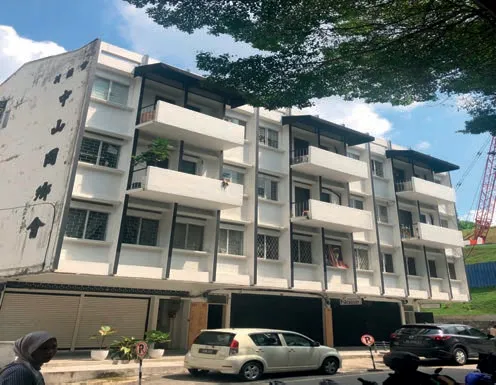
1

2
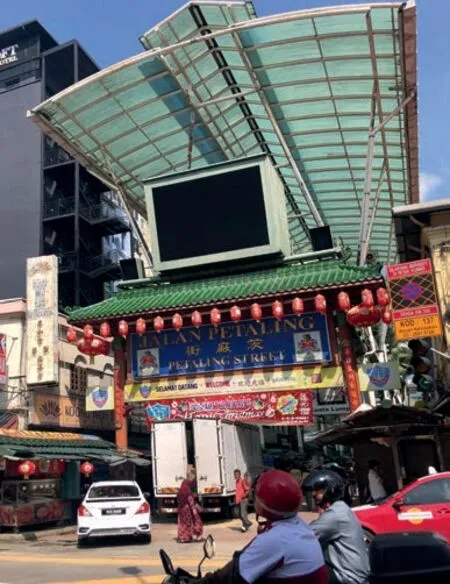
3
1 吉隆坡中山联合会大楼/Zhongshan Building, Kuala Lumpur
2 吉隆坡丽士杂锦/REXKL, Kuala Lumpur
3 八打灵街的主入口/Main Entrance of Petaling Street
第三空间的重要品质包括这些:
(1)它们具有包容性,且富于本土特色;
(2)它们提供的环境能让每位成员都彼此相识;
(3)它们是来访者的入口空间;
(4)它们为人们之间进行对话、沟通想法和社会规范提供“中性的场地”;
(5)它们提供游戏和玩乐的场所;
(6)它们为人们提供归属感和彼此连结。
尽管这一观点是西方中心主义的,它仍能为马来西亚城市空间的社区建设提供理论框架。作为现代社区建筑,第三空间的功能是社区生活的“锚点”,能推动个体之间更广泛的互动。在马来西亚——其他亚洲国家也很常见——社区通过各种功能的文化和消费活动来形成,如商业、娱乐和文化活动。能够描绘出第三空间的城市环境包括:
(1)餐饮业——如星巴克、麦当劳和嘛嘛档i;
(2)郊区商场和集贸市场;
(3)创意空间——如马来西亚吉隆坡中山联合会大楼和丽士杂锦ii;
(4)充满消费和旅游活动的街道,如餐厅酒店街——如茨厂街iii;
(5)新建的镇区——如生态阿尔当斯的生活方式实验室。
我们常见的例子包括城市里的购物商场、公园、咖啡馆和图书馆等让人们汇聚在一起的场所。尽管前两者在马来西亚的城市环境已司空平常,后三者则正在对马来西亚的社区建设城市产生新的影响。这些场所通过建成环境中形成的社会学和环境要素催化和推动社区营建。其中常见的主题是建筑学和建成环境的内涵可延展性。例如,对一座建筑、一条街道、一片路网、一处(郊区或城市)空间来说,它可以是小巧而具有地方特色的,也可以是庞大而国际化的。
3 点:建筑针灸/植入
最近几年,出现了在城市背景下建设创意中心或创意空间的趋势。我把这一情况称为“点”,也就是通过插入一座单独的建筑或空间来进行社区建设。这类建设通常由草根阶层发起,在马来西亚,这些空间非常依赖文化的影响和消费行为,或称为“文化第三空间”。相关的案例包括各类对旧建筑进行的适应性改造(通常具有文化和历史价值)。其中一些包括马来西亚吉隆坡中山联合会大楼和“丽士杂锦”——后者主要由涉及或经营创新艺术或创意产业的利益相关方投资建设。
位于吉隆坡甘榜亚答的马来西亚吉隆坡中山联合会大楼,是一个市中心的改造项目(图1)。甘榜亚答是一片蒸蒸日上的创意区域,在其创意片区中聚集了各种商业机构和非盈利机构。这座建筑在1950年代曾是一整排内部连通的商店,雪兰莪州中山联合会就坐落在其中,它是一家经营多年的冷冻食品经销商和其他品牌的代理商。然而时过境迁,这座建筑物遭废弃,直到最近才由其目前的业主通过城市复兴代理“思考城市”获得资金对其进行改造,成为独立的艺术和研究中心,由此获得新生。“我们的艺术”项目,作为一座画廊和艺术顾问也同样参与了中山联合会建筑大楼的开发。
另一个最近的案例是丽士杂锦,那里曾是吉隆坡电影形象的集大成者,于2002年停业,后来被改造为背包青年旅社。建筑在2007年大火之后一直遭到闲置,现在经过修整和改造,成为艺术和文化中心,为各种大型活动、剧院演出、展览、表演、放映、图书馆、工作坊、零售和民宿提供空间。其创意由本土设计师曾宪炘和郑顺升发起(图2,见76页)。
4 线:作为共享空间的街道和路网
尽管社区的概念非常广博,在建筑学中,它还是由促进社会交往的不同空间所构成。马来西亚(亚洲的)市场街道所提供的空间特征能够通过共享空间形成社区。它提供了各种商业和文化的第三空间,推动了无数与人们的日常生活和旅游与消费主义的影响相关的社区活动。
共享空间是把街道转化为此类第三空间的途径。共享空间的概念来自英国交通工程领域的观念,具体指降低机动车优先级,并使街道更人性化的设计方法。公共空间项目(PPS)提出了共享空间的综合定义,即“它是整体规划、设计和维护公共空间的新概念,首先考虑空间所有使用者的利益和个人责任的设计方法。”这一定义关注共享空间的社会层面,以及通过在共享空间的不同使用者之间形成互动来营造社区意识的实践方法。共享空间为拥有不同传统背景的人群提供了见面的机会,这些机会带来的沟通契机可以帮助消弭壁垒。
尽管这是西方中心主义的观念,越来越多的亚洲观点也产生了对“街道”的类似关注,认为它是公共生活的重要组成部分。亚洲的街道非常独特,其特点是流动和灵活,与西方国家相比,它们的使用强度更高。如果没有八打灵街,吉隆坡的历史将大为不同,这条街道有非常繁荣的贸易,且把几个不同的社区连结在一起(图3)。八打灵街是马来西亚的唐人街,聚居着早在1800年追随开采锡矿产业的繁荣而来的定居者。其中大部分都是客家人和广东人,他们还带来了持续迁入吉隆坡的中国移民潮。
Important qualities of third places includes the following:
(1) They are inclusive and local
(2) They create an environment in which everybody knows just about everybody
(3) They serve as ports of entry for visitors
(4) They offer a "neutral ground" space for conversation, idea sharing, and the transmittal of social norms
(5) Create places for fun and enjoyment
(6) Create a sense of belonging and connectedness
While this concept is Western-centric, it can be used to frame the creation of communities in Malaysian urban places. As a modern day community building, third places act are the "anchors" of community life that helps foster broader interaction among individuals. In Malaysia, and commonly experienced in other Asian countries, communities are formed through culture and consumption with functional factors such as commercial, recreational and cultural activities. Some urban conditions that portrays the notion of third place are:
(1) Food & Beverage settings - for example Starbucks, McDonald's and the Mamak Stall
(2) Suburban malls and marketplaces;
(3) Creative Spaces - for example Zhongshan Building and REXKL;
(4) Streets underpinned by consumerism and tourism driven programmes such as Café-hotelstreet - for example Petaling Street;
(5) New Townships - for example Eco Ardence's Lifestyle Lab
It is common that we see exemplars such as the shopping mall, the urban parks, the cafe, and the library being functions in the city that bring people together. While the first two exemplars have been a common scenario in Malaysian urban contexts, the latter three are contemporary exemplars that created new impact on building communities in Malaysia.These places are catalytic in building communities through the sociological and environmental conditions within the built environment. What appears as a common theme within these are the scalability of architecture and the built environment.For example, it can be small and local, or macro and global i.e. specific to a single building, a street, a network of streets, and a (suburban/urban) place.
3 The point: architecture acupuncture/insertion
In recent years, there has been an emerging trend for creative hubs and spaces within the urban contexts. I call this condition the "point", which characterises architecture that builds communities through a single insertion for example a building or a space. Usually initialised by grassroots, such spaces in the Malaysian context is very much dependent on the influence and consumption of culture, or cultural third place. Examples include adaptive reuses of old buildings (usually with cultural and historical significances). Several examples include the Zhongshan Building, and REXKL, mostly patronised by stakeholders who are involved and immersed in creative arts and industries.
The Zhongshan Building in Kampung Attap,Kuala Lumpur, a repurposed building in central Kuala Lumpur is an up-and-coming creative cluster that hosts a wide variety of businesses as well as non-profit organisations in the creative sector (Fig.1). It was once a row of the 1950s interconnected shophouses, which housed the Selangor Zhongshan Association, a frozen foods distributor and various merchants over the years.However, over time the building became abandoned and only recently was given a new lease of life as independent arts and research hub by its current owners with funding from the urban rejuvenation agency Think City. OUR ArtProjects, a gallery space and art consultancy was closely involved with the development of the Zhongshan Building.
Another recent example is REXKL, an old iconic cinema in Kuala Lumpur which ceased operations in 2002, and was later converted into a backpacker's hostel. It has been left vacant after the 2007 fire,and now it has been adapted and repurposed as an arts and culture hub with space for events, theatre,exhibitions, performances, screenings, library facilities, workshops, retail and F&B. The initiative is led by local designers Shin Chang and Shin Tseng(Fig.2, see page 76).
4 The line: the streets and its networks as shared space
Notwithstanding the broadness of the term,in architecture, community is built when there is a variety of spaces that fosters social interactions.The Malaysian (Asian) market streets offer a spatial characteristic which enables the creation of communities through shared space. It provides diverse spatial conditions of commercial and cultural third place that foster myriad of communities related to the everyday life, and the influence of tourism and consumerism.
Shared space is a tool for transforming streets as such third places. The notion of shared space originated from the UK from a traffic engineering point of view, defined as a design approach that seeks to de-prioritise vehicles and humanising the road. The Project for Public Space (PPS) provided a more comprehensive definition of shared space as a "new concept of holistic planning, designing and maintaining public space, in which the design is done in such a way that interests and the individual responsibility of all users of that space comes first".This definition focuses on the social aspects of shared space, and the ways in which the practice works to build a sense of community through interactions between different users in shared space. Shared space holds the potential chance for encounters among people of diverse traditions, and in such chances rests the opportunity for exchange that can help break barriers.
While this is a Western-centric concept,emerging Asian perspectives are similarly focused on the "street" as a significant constituent to public life. The Asian street is unique as it is characterised by mobility and flexibility, with a higher intensity of temporary usage as compared to that in Western countries. The history of Kuala Lumpur would not be the same without the emergence of Petaling Street, a street that continues to thrive on various trades, and bring together diverse communities(Fig.3). Petaling Street is Malaysia's Chinatown, a place where early settlers came to Kuala Lumpur in pursuit of wealth from the booming tin mining industry in the 1800s. Most of the settlers were Hakka and Cantonese, and led a steady migration of Chinese communities into the city.
In 2003, under the local government Kuala Lumpur City Hall (DBKL), Petaling Street underwent a major RM11 mil face lift when two large Chinese arches to welcome visitors were placed at either end of the street. A green roof cover was constructed,covering the whole street, dubbed the "Green Dragon". The street is now totally pedestrianised and transformed into a pedestrian street, a "public living room" for the communities. With the street closed off to motorists, visitors to Petaling Street have easier access to the many stalls set up along the road. At present, Petaling Street offers microcosms to many diverse communities. It is at the same time associated with a variety of programmes apart from"Chinatown", such as "Chinese market", "bootleg market", "night market" and a "red-light area",with multiple and relative "operating hours" that offer settings for diverse communities. The sociospatial aspect of the street has been expanded in the recent years through the consumption of cultural and heritage value of the street. This condition is witnessed by emergence of modern cafes and hotels along the street such as Merchant's Lane, Chocha Foodstore, Urban Artisan, and Lantern Hotel amongst others (Fig.4,5).
2003年,在吉隆坡市政厅当地政府在任时,斥资1100万马来西亚令吉对八打灵街进行整修,并在街道两端新建了两座中国牌坊。并用绿色顶棚覆盖整条街道,被称为“碧龙”。这条街现在全部都被改造为步行街,成为社区“公共客厅”。由于街道不准摩托车进入,去往八打灵街的行人能够更方便地出入沿街商铺。现在,八打灵街是各种不同社区的微缩宇宙。它同时与除了“中国城”之外的其他设施也有联系,如“中国市场”“水货市场”“夜市”和“红灯区”等,不同的“开放时间”为不同的社区提供必要的环境。街道的社会空间属性通过街道文化和遗产价值的消费得到了拓展。沿着商人街、乔查食品店、城市工艺品店、灯笼酒店等如雨后春笋般出现的沿街现代咖啡厅和酒店见证了这一切(图4、5)。
5 面:建筑作为场所营造者
通过对建筑进行功能改造,草根在社区建设中扮演了一定的角色;而开发商则为建设新的社区发展了场所营造的策略。在具有强烈“地域意识”的场所,居民和游客有强烈的归属感。诚然,这是开发商想要形成的地域意识。通常来说,场所营造植根于本土社区的资产、灵感和想要为社区创造能够促进人们健康、愉快和幸福生活的公共空间的潜在意愿。它通过建筑材料、形式和环境来表达场所的独特性,并激励、邀请、联系和呼吁使用者采取行动。新开发项目形成之时会发生什么?社区如何建设?新的场所如何形成?
通过更广阔的实体经济概念,形成了新的开发项目和郊区场所。场所营建作为一种经济开发策略,也称为实体经济开发项目,是通过社区公共基础设施的建设推动经济的过程。它集合了场所营造、经济发展和真正的房地产业。
为了激发新场所的活力(或激活沉睡的场所),日益明显的趋势包括了临时的场所营造。它能在相对较小的尺度上实验不同的想法,然后发展其中实施有效的方案。例如,最近10年内,生态世界发展集团有限公司(EWDG)作为开发商用“生活方式实验室”作为卖点开发新的镇区住宅项目,让消费者能在其中感受到,会在他们的开发项目中有怎样的生活体验。对这家开发商来说,生活方式不仅与基础设施和建筑审美有关,也涉及氛围和场所营造的方面。许多这样的实验室就设计在海运集装箱中。实验室中包含了针对形成社区的商业、零售、健身和休闲功能。开发商还试图为创业者或现有的运营商提供能在决定投入新市场或开启新业务之前进行试营业的空间。
阿尔当斯实验室的官方网站上描述了社区社交空间概念的内容(图6-8),它是一处由艺术、文化和商业决定的第三空间:
“阿尔当斯实验室,不只是一处商业地产,更是一处社区和谐发展的场所。它是好友叙旧和家庭团聚的完美场所,人们可以在此一起享用咖啡,或仅仅是和你亲爱的另一半度过闲适的一天。每次来到这里的每个人都能在此享受无尽的欢乐。阿尔当斯实验室每年为您组织各种可与志同道合的朋友共同参与的社区活动。从专业表演到美食节,阿尔当斯实验室想要培养您的文化品位、开拓您的眼界,让您充分享受优雅生活的艺术。”
6 网:有影响力的建筑
社会媒体的日益增长已经为人们探索和重现空间,以及在当代网络社会中——尤其是在城市环境下——营造场所找到了新的途径。例如,数字场所营造经常通过举办活动来扩大当代场所营造的影响。21世纪,社交媒体又提供了新的途径,通过加强人们与场地的联系,共享场地的组织资源和推动社区形式,提高了场所的潜在品质。其结果是,具有分享意义和情感价值的场所概念在文化全球化的同质化趋势下得到了复兴(图9、10)。
然而,正如奥尔登堡所注意到的,建设真实社区的最有效方式似乎仍是人们容易抵达并经常能与其他人发生联系的物理空间。本文从建筑学和建成环境的角度,通过第三空间的概念和其他社会学空间概念来展开讨论空间特征在社区建造中的作用。通过一些案例说明了建筑学如何能够通过一座建筑、一条街道及其路网和新形成的场所发挥作用,以及社交媒体如何激活新的建成环境。
目前,建筑学和设计构思在社区建设中的作用似乎已围绕和作为文化体验的第三空间概念展开;作为休闲娱乐场所的第三空间;作为娱乐和游戏场所的第三空间;以及作为健康和环境的第三空间。同样,建筑学需要面对日趋变化的社区概念,即如何建设社区的跨学科本质,也需要面对这些概念的内涵可延展性及其利益相关者。不断变化的跨学科社区概念经常重新反映在建筑学对社区建设的其他相关学科相联系的动态作用方面。□
译注/Notes from Translator
i 嘛嘛档指由马来西亚的淡米尔裔穆斯林所经营的饮食档。
ii 前身为茨厂街柏屏戏院(Rex Cinema),经历过多次改造后,成为吉隆坡重要的文化中心。
iii 马来西亚茨厂街(Petaling Street)是马来西亚首都吉隆坡著名的唐人街,也是著名的购物街。

4

5
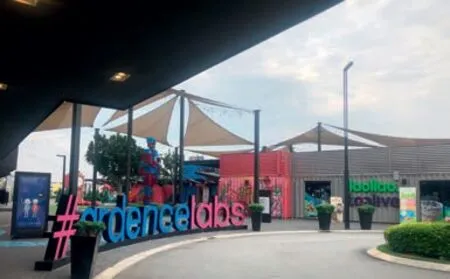
7

6
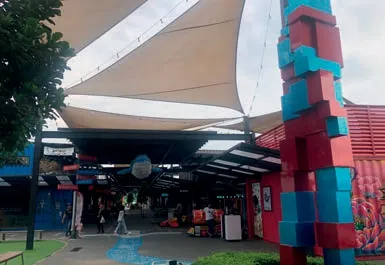
8

9

10
4 八打灵街的内部,两侧布满商店和作为公共空间的五脚基外廊/Interior Street of Petaling Street flanked by shops and five foot way as Shared Space
5 沿着八打灵街的灯笼酒店/Lantern Hotel along Petaling Street
6 阿尔当斯实验室的鸟瞰/Aerial view of Ardence Labs (图片来源/Sources: http://www.ardencelabs.my/)
7 阿尔当斯实验室,位于莎阿南的一座生态世界生活方式实验室/Ardence Labs, one of EcoWorld lifestyle labs at Setia Alam
8 用海运集装箱建造的廊道,阿尔当斯实验室/Arcades created by shipping containers, Ardence Labs
9“脸书”上的丽士杂锦(左图),“即时电报”上的中山联合会大楼/REXKL on Facebook (left), Zhongshan Building on Instagram (Right)
10“脸书”上的阿尔当斯实验室/Ardence Labs on Facebook(1-5,7,8摄影/Photos: Veronica Ng)
5 The platform: architecture as place-maker
While grassroots played a role in creating communities through re-purposing of building,the developers have been developing strategies of place-making in order to create new communities.Places said to have a strong "sense of place" have a strong identity that is deeply felt by inhabitants and visitors. Indeed, it is a sense of place that developers seek to fabricate. Typically, place-making capitalises on a local community's assets, inspiration, and potential with the intention of creating public spaces for communities that promote people's health,happiness, and well-being. It uses materiality, form and context to express the uniqueness of the place and inspire, engage, connect and call users to action.What happens when new developments are created?How are communities built? How is a new place created?
Through the broader concept of place-based economic development, new developments and suburban places are formed. Place-making as an economic development strategy, also called placebased economic development, is the practice of using a community's public amenities to make economic progress. It combines place-making,economic development and is real estate related.
To ignite new places (or activating dormant places), emerging trends include temporary place-making. It allows experimentation with a variety of ideas on a smaller scale, and then grows what worked. For example, in the recent decade,developer Eco World Development Group Bhd(EcoWorld) has utilised the concept of the "lifestyle labs" as a strategy to develop new residential townships that allows customers to experience what it feels like to live in their developments. To this developer, lifestyle is not just about facilities and building aesthetics, it is also about ambience and place-making. Many of the labs are housed in shipping containers. The labs house commercial,retail, fitness and recreational programmes that anchor to the formation of communities. The developer also intends to provide a space for startups or existing operators to do try-outs before they decide to venture into a new market, or start their own business.
Excerpt from the official Ardence Labs website exemplifies the notion of a social space for community (Fig.6-8), a third place underpinned by arts, culture and commerce:
"Ardence Labs, a place for more than just a business affair, is also a place where community grows together in a harmonious pace. Perfect for friends to catch up and families to bond, this is a space where you can enjoy each other's company over a cup of coffee or just spend the day relaxing with your loved ones. Endless enjoyment for everyone, every time. Ardence Labs also curates community events throughout the year for you to meet and mingle with like-minded people. From special performances to food festivals, Ardence Labs wants you to cultivate your cultures and broaden your perspectives so that you'll truly enjoy the art of living beautifully."
6 The web: architecture of influence
The growing presence of the social media has made into new ways for exploration and re-imaginging of place and place-making in contemporary network society, urban environments in particular. For example, it is used as part of digital place-making, and often used to amplify temporary place-making through events. In the 21st century, social media provide new opportunities as it boosts place potential by heightening people's engagement with places, sharing place association and community formation. Resultantly, the idea of place as having shared meanings and sentimental value is resurrected in the face of the homogenising tendencies of cultural globalisation (Fig.9,10).
However, as Oldenburg notes, the most effective ones for building real communities seem to be physical places where people can easily and routinely connect with each other. In relating to architecture and the built environment, this article has provided a glimpse of the Malaysian condition by utilising the notions of third place and other socio-spatial concepts to unpack how spatial characteristics play a role in building communities. It illustrated, through few examples, how architecture can play a role through a single building, a street and its network and a new place, as well as the new environments enabled via social media.
At present, the role of architecture and design thinking that builds communities appears to evolve around notions of third place as cultural experiences;third place as entertainment and recreation; and,third place as health and environment. Also,architecture needs to address evolving conception of community, the trans-disciplinary nature on how to build communities and to address the scalability of these ideas, and its stakeholders.Being transdisciplinary and evolving, the notion of community is constantly re-imagined resulting in the dynamic role of architecture in association to other related disciplines in building communities.□
参考文献/References
[1] UTABERTA N, SPALIE N, NIK SYAZWAN N. Review on the community centre design in Malaysia: Problems of object centre discourse and failure to address cultural context in modern community in Malaysia. 2014//Recent Trends in Social and Behaviour Sciences -Proceedings of the 2nd International Congress on Interdisciplinary Behavior and Social Sciences 2013,ICIBSoS 2013: 95-100.
[2] NURUL W, WAN M, RANI M. American Transactions on Engineering & Applied Sciences Understanding the Usage Pattern of Local Facilities in Urban Neighbourhood towards Creating a Livable City.American Transactions on Engineering & Applied Sciences, 2014(3(2)): 129-148.
[3] MCMILLAN D W, CHAVIS D M. Sense of Community:A Definition and Theory. Journal of Community Psychology, 1986(14): 6-23.
[4] KAPLAN R, STEPHEN K. Humanscape: Environments for People. Ann Arbor, Mich.: Ulrich's Books, 1982.
[5] OLDENBURG R. The great good place: Cafés, coffee shops, bookstores, bars, hair salons, and other hangouts at the heart of a community. New York:Marlowe, 1999.
[6] OLDENBURG R. Celebrating the third place: Inspiring stories about the "great good places" at the heart of our communities. 2001.
[7] PINE B J, GILMORE J H. The Experience Economy.Harvard Business School Press, Boston, 1999.
[8] JEFFRES L, BRACKEN C, JIAN G, CASEY M. The Impact of Th ird Places on Community Quality of Life.Applied Research in Quality of Life, 2009.
[9] Project for Public Space. [2019-12-10] https://www.pps.org/.

